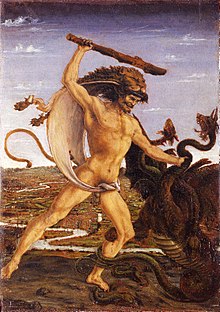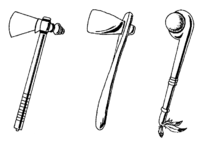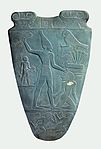Club
| Club | |
|---|---|

|
|
| Information | |
| Weapon type: | Club |
| Designations: | Club, beating |
| Use: | War weapon, civil weapon, hunting weapon |
| Creation time: | approx. 2 million BC Chr. |
| Working time: | until now |
| Distribution: | worldwide |
| Overall length: | approx. 50 cm to 200 cm |
| Handle: | Wood, metal |
| Particularities: | different shapes and sizes |
| Lists on the subject | |
The club , also known as a stick , a stick or a beating (from Middle High German brügel , "beating, stirring rod"), generally falls under the category of percussion weapons because it does not penetrate the body when used . However, there are also versions that are equipped with spikes or a point. These then also fall under the cutting weapon , since they penetrate the body when they are used.
origin
For the stock see: Stock (prehistory and early history)
The club is probably one of the oldest weapons of man (see scree club ) and originally probably consisted of a naturally thickened branch or root wood; animal thigh bones are also possible. All types increased the power of the arm and ensured a certain distance to the opponent. Later stones were attached to sticks with vegetable fibers; even later holes were drilled into the stones through which a (polished) branch was stuck. In terms of the stick , which is used for striking, the use of clubs in chimpanzees can also be demonstrated.
The device with handle and thickening is ideal for swinging, both for striking as well as for throwing and implements a principle that is implemented in the tools based on the club such as the hammer and the hatchet , as in all tools optimized for swinging Tools with handles and heads. Technically, the club is a simple machine .
The first secured clubs date from the Mesolithic . They are round, spherical, disc-shaped or flat, rectangular-shaped stone heads with holes. Round club heads made of stone are the successors of the clubs made of wood and appear as rubble clubs . The perforation was made by funnel-shaped picking or as a full bore; since the Neolithic also as a hollow bore. In the Maglemose culture there was a type that probably developed from the cylinder hatchet . These clubs have a flat tenon, often with a hole or notch for tying up. The blunt neck end of the cylinder ax, highlighted in a thicker way, forms the striking surface. In France, a club head made of flint from the Campignia was found, which is apparently an imitation of a rock tool. One feature is that many were made from visually striking types of rock, usually glacial erratics. Several types have been defined, mainly by Fiona Roe who proposed a British typology in 1979 which has since been discarded. Antler clubs with all rods removed are rarer. A wooden club was found in Kalambofalls ( Zambia ), the age of which is about 200,000 years. Presumably the club was used to kill animals. Even the Egyptian king Narmer , the unifier of Upper and Lower Egypt, settled around 3000 BC. On the famous stone palette with a club. It is also one of the attributes of the Hindu god Vishnu .
Word origin

The word "Keule", Middle High German kiule , not proven in Old High German , is linguistically close to "Kolben" and perhaps originally to " Kugel " and " Keil ". The old-fashioned way to write a kule is (cf. tadpole ). "Knüppel" stands for " Knüpfel / Klöpfel" in the meaning of "hammer", but also in proximity to " Knot , Knorren, Knubbel" in the meaning of "Bulge" (on wood), and " Klöppeln ". "Knüttel" is the more original, Old High German word (chnutil, chnuttil, kinuttil) , and means " round wood ", in the Middle Ages it was a knightly weapon ( piston ), later reduced to " knot stick " (see Knittelvers ). “Beat”, first from the 16th century, Upper German Brügel , also originally means a piece of round wood, then generally in the same context as a beating or throwing stick (cf. beatings , Austrian “throwing someone Brügel between the legs”: “somebody's stones Put away "). Also Flegel is approximately the same meanings as those three words, and mallets / Schlegel is the word "club" closely related semantically. All of these words consistently stand as a swear word for small, plump stature or transferred for coarseness and rudeness. In the Berlin dialect , “club” stands for the (younger) brother .
The association of “club” and “striking” is so close that the word “ club ”, originally “ knock down with the club”, also “club down” (analogous formations: dagger - dagger, spear - spear ) only in veterinary medicine or agricultural animal husbandry means "killing an animal" - regardless of the method. Today there is even an explicit distinction between “ slaughtering ” in the context of epidemic protection for killing without adding to the food chain.
Different usage of the word
A club is a rather crude weapon compared to others. Similarly, in spoken disputes (verbal battles), the "verbal club" can be used, for example in the form of " murderous arguments ".
The use of chemicals to control pests is often referred to as using the "chemical club". In addition, Smith & Wesson's Chemical Mace was the first irritant sprayer .
Derived Devices
Tools
Due to its principle, the club can be seen as the main shape of the hammer . Numerous tools are derived from it. In addition, the combination with the wedge , which is suitable as a separating tool, creates in particular all variants of the ax , hatchet and dexel .
Origin of the combination of the club principle with that of the wedge (here: hand ax on the lever arm)
Sketches of three tomahawks , on the right a stone ax of Stone Age design set as a club, on the left development of the modern hand ax
weapons
The club also serves as a primitive striking weapon , consisting of a handle and a heavy, massive end. Typical variants are truncheons (rubber truncheons, police truncheons), maces and war hammers , further developments are the morning star (stocking with spears) or the flail (loosening with a chain).
Narmer Palette (Egypt, around 3000 BC)
Club of Vishnus (around 1200 AD)
two Māori warriors with Taiaha (New Zealand, 19th century)
Sports equipment
As a piece of sports equipment, the club has also led to a variety of playful use of simple mechanics:
- Club as an object to juggle
- In addition to the ball, rope, hoop and stick, this is one of the hand tools in rhythmic gymnastics
- also hockey and baseball bats and bats of numerous other sports
See also
Web links
Individual evidence
- ^ Emil Hoffmann: Lexicon of the Stone Age. Beck'sche Reihe, Volume 1325. Beck Verlag, Munich 1999, ISBN 3-406-42125-3 . P. 203.
- ↑ KEULE, f. clava, fustis, femur . In: Jacob Grimm , Wilhelm Grimm : German Dictionary . Hirzel, Leipzig 1854–1961 ( woerterbuchnetz.de , University of Trier).
- ↑ STUD, m. like knüpfel, sd, and like this, vacillating between two origins . In: Grimm: German dictionary. Hirzel, Leipzig 1854–1961 ( woerterbuchnetz.de , University of Trier).
- ↑ KNÜTTEL, m. clava nodosa, fustis, nodulus . In: Grimm: German dictionary. Hirzel, Leipzig 1854–1961 ( woerterbuchnetz.de , University of Trier).
- ↑ BRÜGEL, m. fustis, today written beatings . In: Grimm: German dictionary. Hirzel, Leipzig 1854–1961 ( woerterbuchnetz.de , University of Trier).
- ↑ beatings, m . In: Grimm: German dictionary. Hirzel, Leipzig 1854–1961 ( woerterbuchnetz.de , University of Trier).
- ↑ Horst Naumann (ed.): Family name book . Bibliographisches Institut, Leipzig 1989, p. 261 f .
- ↑ CLUB, hit the club . In: Jacob Grimm, Wilhelm Grimm: German Dictionary. Hirzel, Leipzig 1854–1961 ( woerterbuchnetz.de , University of Trier).
- ^ Society for German Language (Ed.): Sprachdienst . No. 1 , 2001, p. 22, 49 . Or: Questions and Answers: Origin of 'clubs'. Society for the German Language, accessed on July 7, 2016 .







